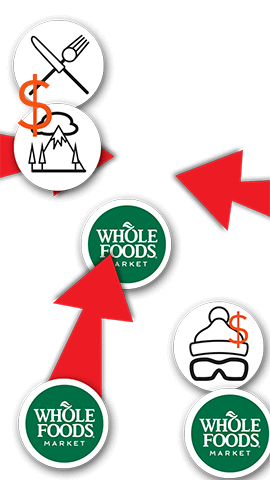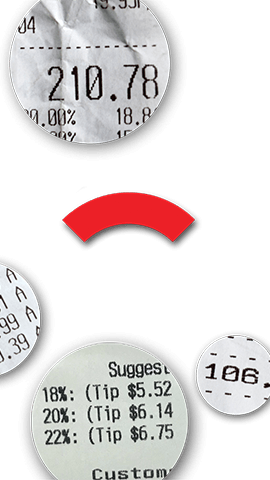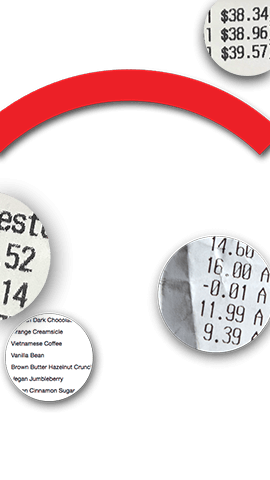
Every step you take
How companies use geolocation data to target you — and everyone around — in ways you're not even aware of
It’s Monday, 6:15 a.m. The alarm sounds, and as I reach for my phone, half-asleep in the dawn, the tracking begins. Going about my daily routine — the commute to work, settling into my desk, then ducking out for lunch or meetings — I’m swiping, clicking, tapping, and typing on my smartphone. All the while, I’m being followed by firms that are tracking, and targeting me, with every step I take.
But it’s not hackers or voyeurs following my movements. In fact, I’ve actually welcomed these observers into my life, and sometimes don’t even notice they’re there. But they’re paying minute attention to my every move, then firing away with advertisements, designed for that moment, and just for me.
Most of us now live here, or soon will — at the slightly queasy intersection of consumerism and surveillance.
The dozens of apps on our phones, most of them free, aren’t just serving up information and entertainment. Many are able to ascertain our whereabouts based on the phone’s GPS and can then sell that geolocation data to digital marketers. Unlike traditional print or television ads, location-based marketing has the benefit of knowing where we are, whom we’re with, and whether their ads are working.
Geotargeted mobile marketing is one of the fastest growing forms of advertising — and one of the most controversial. It has arisen in part because, as more of us use streaming and on-demand viewing services, we’re watching far fewer television ads. And because so many of us carry our smartphones at all times, digital marketers have seized the opportunity to gather and sell data on where we are, what we do — and what we might want to buy. In 2017, marketers spent $17.1 billion on geotargeted mobile ads, and the research firm BIA Advisory Services forecasts that number will more than double to $38.7 billion by 2022.
Or, as Rick Ducey, a digital strategy adviser with BIA Advisory Services put it in a recent study: “Where you go is who you are.”
Think about it for a second: Even if you don’t share your address, your profession, or what you bought online this year, much could be gleaned from the places you frequent. Do you make a daily visit to the gym? Work in a tall office tower? Wander into a store while taking a lunch break? Each pinpoint on the map of your day helps create a profile, or “audience segment,” that can be used to serve you ads.
DATA COLLECTION: WAKING UP
DATA COLLECTION: WAKING UP















The tech: A GPS and Wi-Fi chip are installed in every smartphone. Every phone is also constantly pinging the nearest cellular data tower.
What they know: Based on how long your phone has been still, data marketing firms know where you sleep and where you likely live.
From this, they can infer your income level.
They also know what apps are on your phone and what content you most recently viewed.
All of this information is being constantly shared with marketing companies.
What they can do with this info: Those companies can pair data about your interests with income level and target you the minute you look at your phone again.
If you’re waking up on a college campus, then beer companies might want your eyeballs. Or if you live in a posh suburb, for example, they might target you with ads for luxury cars.
This surge in geotargeted ads is raising the ire of privacy advocates, who say marketers can learn far more about us from our location data than we may realize. David Choffnes, an assistant professor of computer science at Northeastern University, has found that some retailers’ apps, running in the background of our phones, collect the GPS coordinates from users every two minutes.
From such drab and fleeting details, a revealing picture emerges.
“Not only can I see where you work and live, but I can see where you worship, if you go to a doctor’s office, or what support groups you might be attending,” said Gennie Gebhart, a researcher at the Electronic Frontier Foundation.
Here’s how the ads find us: Our phone carriers combine cellular data and the phone’s built-in GPS to keep tabs on where we are at all times. That, coupled with your phone’s Wi-Fi, which regularly pings off available networks, creates a base line of geolocation data.
Apps add more data to your profile. Many offer a prompt when you download them, asking whether they can collect details on your location. They can then anonymize and sell that data to marketers or other intermediaries who can target you with advertising or use that data to make business decisions. Even if you opt out of location tracing, many can still pull information about where you are from other sources, such as your social media profiles.
DATA COLLECTION: COMMUTING TO WORK
DATA COLLECTION: COMMUTING TO WORK

















The tech: Phones constantly broadcast user locations.
As you walk to the train, you pass a Starbucks. Your phone pings the Starbucks Wi-Fi network and it recognizes that you’re nearby. Starbucks can then send you a coupon offering a discount latte.
Meanwhile, a competitor like Dunkin’ Donuts might use geofencing — virtual geographic boundaries — to send you an ad for its coffee instead, and point you toward a nearby location. That’s a technique called geo-conquesting.
If a company is looking to open new storefronts, it might use the foot traffic patterns of its app users to help determine the best locales for new stores.
Once they access the data streams, marketers can begin using the information to target you. As you walk to work, your phone’s GPS and Wi-Fi data leave digital bread crumbs that a coffee shop can use to send you coupons or help select a location for a new store.
If you check in at the gym daily, marketers will know, and ads for Whole Foods or insurance companies can follow you. If you’re shopping online at work and wander out for lunch break, a store nearby might want to let you it has the shoes you’re looking for in stock and will ping you with an ad.
Ducey said the information helps marketers answer questions like: “Where are the people I want to reach and where do they hang out?” Location data can also test the efficacy of ad campaigns — tracking, for example, how many individuals who saw an ad for a store actually show up to shop there.
In the past, companies used basic demographic information to target consumers by age, income level, education, or ethnicity, said John Cheney-Lippold, a professor of Internet Studies at the University of Michigan and the author of “We Are Data.” Then companies began to dig deeper, creating “psychographic profiles” based on our affinities — assessing whether someone is politically liberal or conservative, for example, or identifies as a sports fan or as part of a religious group. This information can be gleaned through surveys, by tracking consumption habits, or through social media, as Cambridge Analytica did by tracking Facebook users in the 2016 elections.
DATA COLLECTION: AT THE GYM
DATA COLLECTION: AT THE GYM













The tech: You may stop by a gym on the way to work, and watch a YouTube exercise video while you spin. Since YouTube is owned by Google, it could feed the geolocation data into your user profile. Or if you use a workout tracking app like Strava, it can also share your whereabouts with marketers.
What they know: Based on your daily fitness routine, marketers can glean that you might fit into a consumer category that’s focused on wellness, healthy diets, or athletic gear.
What they can do with this info: You could expect to see an influx of ads for the nearby Whole Foods or vegetarian restaurants. Or you might get promotions from insurance companies looking for healthy new members. A nearby ski resort might target you with a lift ticket.
GPS data offer a degree of objectivity that cuts through complex and sometimes contradictory information about who we are, Cheney-Lippold said.
“There is something much more intimate in the GPS data,” he said. It has the capacity to track hundreds of data points on things like “how you move through places, and how fast, who you’re moving with, and the places where you stop.”
“There is something very mundane about GPS that also becomes very profitable,” he said. “You can lie about your data, but you can’t lie about your routine. There is something very real about that.”
Of course, this form of tracking has raised privacy concerns. European regulators have begun to crack down on how much personal data companies can gather from the public. This May, the European Union passed the General Data Protection Regulation, or GDPR, which forces Internet companies to ask for consent before gathering any information from users.
DATA COLLECTION: AT WORK
DATA COLLECTION: AT WORK












The tech: If you log onto a shopping site with your e-mail or Facebook account, personal identification details are added to your geolocation data.
What they know: Just as marketers can determine where you live based on where your phone is overnight, they’re also able to figure out where you work, and potentially the type of work you do, based on where your phone resides during the day — in an office, in a factory, or at a restaurant or retail store.
What they can do with this info: That search info can trigger ads for the brand, or companies that carry it, that carry over from your desktop computer to your phone. If a brand is aware that you’re shopping for its product, it can send a push notification through its app if you’re nearby a store. Or it can offer targeted ads based on your location — promoting trail running shoes in a high elevation city, for example.
In the United States, we haven’t yet gotten that far. “Companies are now completely legally able to collect your data,” said Choffnes. The strongest consumer protections come through the Federal Trade Commission, which occasionally cracks down on app developers that fail to disclose just how much data they’re collecting, he said.
But the tide is starting to turn: In June, California passed digital privacy legislation that is modeled on the GDPR.
EFF’s Gebhart said that while some phone carriers have begun limiting the information they share with outside parties, consumers should push companies to adopt best practices to protect our privacy.
“In the current landscape we’re living in, it would take an unrealistic diligence of someone with a computer science and law degree to exhaustingly determine what information is being shared with who and when,” she said.
DATA COLLECTION: AFTER WORK
DATA COLLECTION: AFTER WORK











The tech: After work, you meet friends at the bar. You use Venmo to split the tab.
The Venmo payment app syncs your payment data with that of your social circle and keeps credit card numbers on file, linking up with your other purchase habits.
What they know: Companies now are able to see not only where you spend your money, but who you’re spending it with.
What they can do with this info: Your social habits — maybe you swing by this bar on a weekly basis — might make you a good candidate to join a loyalty program or become a brand ambassador who can help promote the company through your social media feed.
Companies buying and selling geolocation data in the United States now number in the thousands, each slicing and dicing data in ways that would make an unwitting smartphone user’s head spin. And they’re not just selling ads but also making correlations between data sets that can be quite illuminating and lucrative to companies.
David Shim, the chief executive of the location analytics firm Placed, pulls data from over 300 million smartphones each month. He said his company’s aim is to become what Nielsen’s service is for TV, or what comScore is for the Web. “Our goal is to make the physical world as measurable as TV and digital,” he said.
Using phone location data, the company has been able to ascertain that Netflix users most frequently dine at In-N-Out and Chili’s restaurants, and that people who own bitcoin currency are most likely to buy Hyundais and shop at Apple. Those kind of insights could help the restaurants target ads or encourage a Hyundai dealership to start accepting bitcoin.
DATA COLLECTION: RELAXING AT HOME
DATA COLLECTION: RELAXING AT HOME










The tech: Once you arrive home, your phone syncs up with the same Wi-Fi network as your smart television, adding your television viewing habits to the data stream. This essentially allows your TV to watch you.
Some of the apps on your phone also have a tool embedded in them called automated content recognition. It works a bit like Shazam in that it’s able to detect audio signals and determine what you’re watching on TV.
What they know: Because many of the mobile apps on the phone cross-license their data, marketers are able to tell whether the ads you’re watching on television are influencing your purchasing habits.
What they can do with this info: Companies can use “dynamic ad insertion” to make sure their ads are visible at the very moment a user’s profile begins to sync up with what you’re clicking on online. And eventually, smart televisions will be able to serve up ads that directly target users, meaning you will see ads that are just for you, not other viewers.
What’s more, using automated content recognition informs companies that you saw an ad — say for a car dealership — and later walked into their store to make a purchase.
MIT Media Lab spinout Thasos Group has developed a platform that uses geolocation data to assess economic activity. For the last seven years, it’s been selling hedge funds anonymized GPS data tracking the activity of factory employees at commodity processing plants the funds have invested in. More recently, Thasos has begun focusing on retail, tracking foot traffic patterns at malls, grocery stores, and more.
Thasos was able to determine, for example, that Whole Foods saw a 17 percent increase in foot traffic last August after its parent company, Amazon, announced it was slashing prices. The company identified Trader Joe’s shoppers as the most common defectors.
Geolocation data provide a degree of “radical transparency” that has the capacity to not only revolutionize the marketing world, but affect real estate, finance, and other industries, Thasos’ founder and chief executive Greg Skibiski said. He believes we need to begin setting standards now to ensure we protect privacy while simultaneously exploring its vast potential. “The data is out there and never coming back,” he said. “And we need rules for it.”
Consumers will need to contemplate those ethical boundaries as daily life more and more frequently intersects with these new digital pathways. Our own geolocation data streams, when combined with those of millions of other users, can reveal powerful patterns. And marketers realize that if “where you go is who you are,” then knowing where all of us are, all of the time, is a force that can shape the future of commerce.

Credits
Editors: Lisa Wangsness, Anica Butler
Copy desk: Mary Creane
Illustration: vectorpocket and MicroOne/Adobe Stock
Illustration and animation: Brendan Lynch, Kevin Wall, and Ryan Huddle
Design Director: Heather Hopp-Bruce
Produced by: Kevin Wall